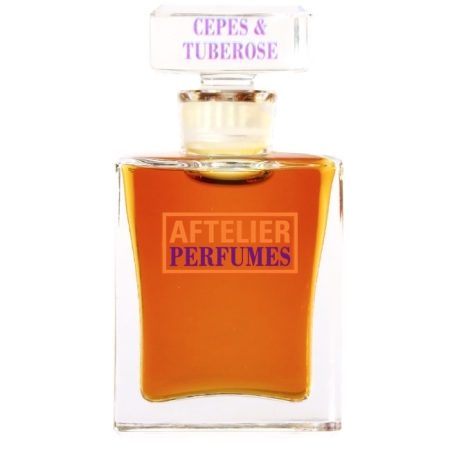
Aftelier Perfumes Cepes and Tuberose
One flower much whiter than the fervent Dove
Whose scent in living purses seem to beat:
Magnetic ardour, drowsy scent of love,
O memory, O presence odours,
Thy life’s perfume, my perfect tuberose!
[Mark André Raffalovich, 1885]
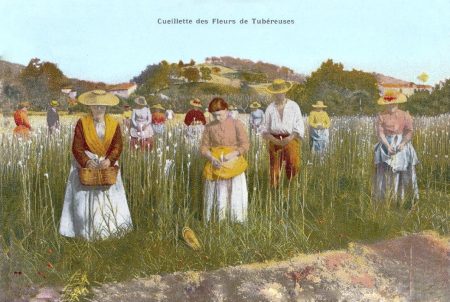
Tuberose harvest – Antique postcard from the Aftel Archive of Curious Scents used for this article Aftelier Perfumes Cepes and Tuberose©
Native to Mexico, tuberose (polianthes tuberosa) is a species related to agave and was called by the Aztecs “Omixochitl” or bone-flower for the shape of the white blooms. Its appearance in Europe was introduced by pre-Columbian legends of troubling love, death, and unrestrained lust. Since then, the voluptuous scent of these white flowers never ceased to inspire poets who adopted it as an emblem for feverish desire and erotic magnetism. Undiluted tuberose absolute is a viscous fluid perfumers always found intimidating for its potency. Fiercely green with lactonic, animalic, and earthy undertones, in tiny amounts it unfolds the hypnotic femininity of the living flower. Few olfactive artists dare to overdose it too generously for only the in-depth knowledge of this raw material allows a perfumer to tame it.
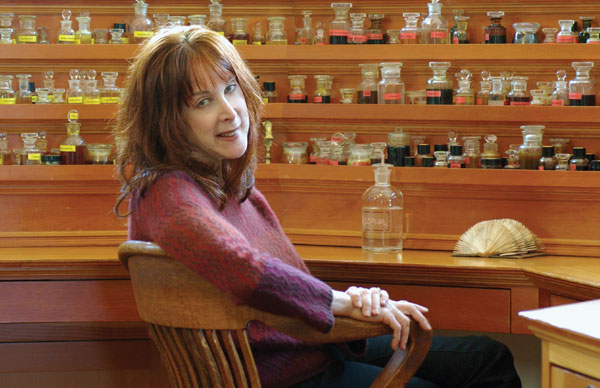
Mandy Aftel photo by Foster Curry©
Expertly balancing tuberose absolute along with the surprising cepes absolute, the genius of Mandy Aftel put a leash on the ferocious animal giving us a unique interpretation of tuberose that brings the beauty of the “amiga de la noche” (lover of the night) to unprecedented vegetal, woody and even gourmand territories. Aftelier Perfumes Cepes and Tuberose is the olfactory equivalent of Surrealism in Art, revolutionizing the fragrance industry by using natural raw materials and isolates only. This makes it a game changer that deserves to be inducted in the ÇaFleureBon Modern Masterpiece Hall of Fame.
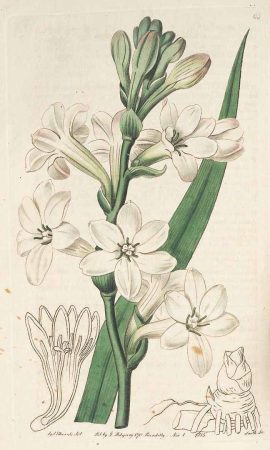
Polianthes tuberosa – Botanical Register, illustration by S. Edwards (1815)
During the Renaissance, young ladies were forbidden to walk through the gardens at night because the alluring scent of tuberose was an intense aphrodisiac. It is said that women would put fresh tuberose under their skirts to attract men. In France, unmarried girls are warned to not inhale the scent after dark. The Victorians ascribed tuberose with voluptuous and sensual characteristics and young girls were forbidden to walk through gardens at night (and sometimes were told not to leave their bedroom windows open) during the blooming for the intense, lustful breath was thought to induce lascivious behavior, malaise, and even hysteric fevers and hallucinations. The poisonous nature of tuberose flowers hardly diminished its popularity. On the contrary it amplified the alchemic charm of love and decay that crowned tuberose as the flower of femmes fatales.
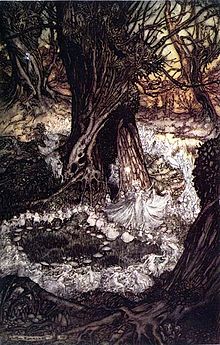
Come, now a rounderl – Illustration by Arthur Rackhan for Shakespeare’s A Midsummer Night’s Dream
Mushrooms not only exude the same green, loamy ripeness of the heady tuberose, but also share the same fairie superstitions as dangerous pleasures. Usually, newbies are advised not to go hunting the delightful porcini mushrooms (boletus edulis, also known as cepes) for it’s possible to mistake their harmful twin boletus satanas, the cep of Satan which ingestion causes fever, nausea, and abdominal pain. The shimmering porcini mushrooms absolute works magic throughout the entire evolution of the perfume, boosting the sappy sparkle on top, as well as signing the woody, almost chypre mischievous closing line.
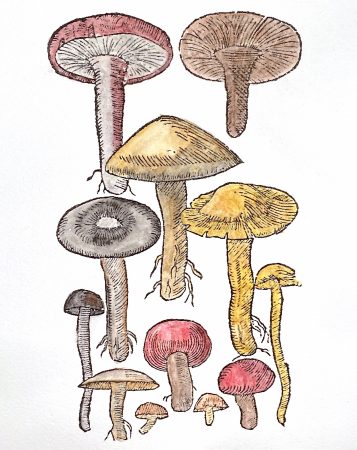
Mushrooms painting by Mandy Aftel
Wearing Aftelier Perfumes Cepes and Tuberose is an olfactory epiphany, and I can never thank enough our editor in chief Michelyn Camen for recommending it as a modern masterpiece. As few drops of the unctuous parfum melts on skin, the curtain on the night opens and mushrooms and white flowers put on a show. The dominant chord of this pas de deux is the green earthiness white flowers like tuberose and gardenia as well as mushrooms possess, a mouthwatering truffle-like freshness distinctly different from grassy galbanum (an easy match with tuberose) or aromatic herbs.
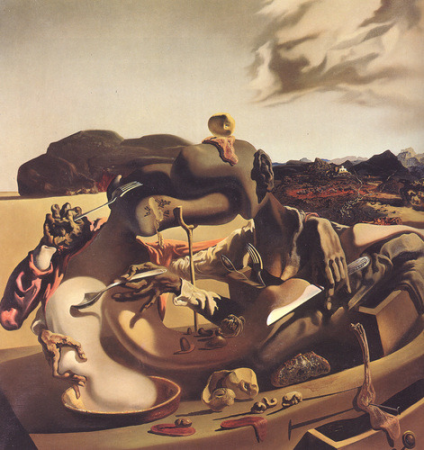
Autumnal Cannibalism, Salvador Dalì (1936)
Soon the opening damp fluorescence softens into pure bliss. We’re on a romantic date, dining to a Michelin star-rated restaurant, and the table is white-on-white with sleek fine bone china crockery over a Flanders tablecloth. A tuberose ikebana centerpiece proudly displays among the tall crystal goblets filled with straw yellow Sauvignon Blanc, and the intoxicating spell of fleshy flowers whispers indecent proposals. The spotless petals radiate their waxy sumptuousness like burning candles on silver candelabra. The cinnamon-sprinkled base notes benzoin and sandalwood smooths the celery-like sassy verdancy of tuberose, wrapping the captivating smell of cepes in an incredibly textured, buttery heaven redolent of exquisite sautéed porcini mushrooms, channeling raw sensuality and sublime gluttony as in Salvador Dali’s Autumnal Cannibalism. Scent is the tempting prelude to kissing, or tasting after all.
While the parfum version of Aftelier Perfumes Cepes and Tuberose lasts longer giving off the luxurious opulence of a floral ointment with waxy and earthy undertones making you crave for more and more, the eau de parfum is lighter and fresher on skin, radiating a delicious green aura that reflects the fruitfulness of nature awakening in the crisp morning air of March, right before the warmth of sunrise kisses the sleeping blooms.
Notes for Aftelier Perfumes Cepes and Tuberose include bitter orange, rosewood, Italian tuberose, cepes absolute, benzoin and sandalwood.
Disclosure: Review based on Parfum and Eau de parfum samples of Aftelier Perfumes Cepes and Tuberose gently provided by Aftelier Perfumes. Opinions are my own.
Ermano Picco, Editor and Perfume Expert
Special acknowledgement to Deputy Editor Ida Meister for planting the seed with her article Fragrance For Foodies
Mandy Aftel is Michelyn’s co-recipient of 2021 Hall of Fame
Thanks to the generosity of Mandy Aftel, we have a mini of Aftelier Perfumes Cepes and Tuberose to one registered reader worldwide with exception of Italy and Spain. The draw is for registered readers only, so be sure to register if you have not done so. To be eligible please let us know what you thought of Ida’s review, and your favorite Aftelier Perfume. Draw close 3/16/2022
Please LIKE our CaFleureBon Modern Masterpiece page on Facebook and your comment will count twice here
Follow us on Instagram @cafleurebonofficial @magnificent @aftelierperfume
